Does The Camera Add Weight
Choosing a tripod tin can be an overwhelming feel, given how many different types and choices nosotros are presented with. On one mitt, a tripod is a very simple tool to go along our cameras steady when we use them in challenging low-cal atmospheric condition. On the other hand, there are so many different variables that come into play when choosing a tripod: How tall should it be? How light should it be? How stable should it be? What kind of weight can it support? How much should I spend on a tripod? These are just some of the questions that might come up as you look into ownership a new tripod.
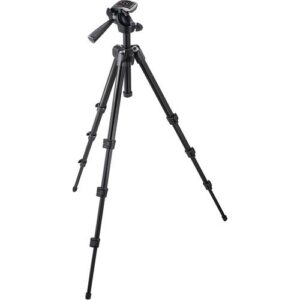
Before getting into the intricate details virtually tripods, I would like to go over the advantages and disadvantages of tripods and why you might need one for your DSLR or mirrorless camera.
Table of Contents
Why Do Yous Need a Tripod?
And so, what is the purpose of a tripod? You might need a tripod for some or all of the post-obit reasons:
- To increase sharpness and depth of field in your images by keeping the camera still in low-light environments when using slow shutter speeds.
- To rest heavy camera gear such as long telephoto lenses on the tripod.
- To increment the quality of the images by keeping the camera ISO low.
- To allow more conscientious limerick, while framing the shot exactly how you want information technology.
- To shoot HDR and panoramic shots that require exactly the same framing and precision.
- To photograph nighttime objects such equally the Moon, planets, stars, etc. too as painting with light or using available light for landscape and architectural photography.
- To do self-portraits with a camera timer.
- To shoot extreme close-ups/macro (flowers, insects, etc).
- To concur various objects such equally flashes, reflectors, etc.
- To shoot at difficult or impossible (hand-held) angles.
- To shoot vibration-gratis videos.
- To defend yourself :)
I personally use a tripod for one main reason – mural photography. Shooting sunrises and sunsets can be quite challenging, particularly when the light weather are far from platonic. Thanks to prototype-stabilized lenses and now cameras with fantabulous built-in image stabilization, the apply of a tripod for most types of photography is not necessary when shooting in daylight conditions.
However, some photographers still prefer to apply a tripod, as it allows them to go along the camera ISO as low every bit possible, which not only keeps the amount of racket in images to a minimum but too provides the highest dynamic range the photographic camera sensor tin can capture. In add-on, a tripod tin help in proper framing of a subject and permit to capture panoramic and HDR images.
Lastly, there are situations where one must employ a tripod in order to boring downward and blur action, such as when photographing streams and waterfalls as shown in the paradigm below. Therefore, if y'all are into landscape photography, a good tripod is a must-have tool in the field.

Occasionally, I might use a tripod for wildlife photography (specifically for bird photography), but non during long hikes, due to inconvenience and weight factors.
Tripod Components – What is a Tripod Organisation?
A tripod system is by and large comprised of the following parts:
- Legs – the obvious. Tripod legs are typically made of aluminum, basalt, steel or carbon fiber.
- Head – the office that holds a digital camera or a lens. There are many different types of heads, but the most popular types are brawl-heads and pan-tilt heads.
- Centerpost/Heart Column – a divide leg that runs through the middle, allowing to further raise the tripod head.
- Anxiety – good tripods allow changing tripod feet at the terminate of the legs for indoor and outdoor use.
The cheapest tripods have legs with an integrated non-replaceable head and feet and sometimes have a centerpost, while the tiptop-of-the-line tripods have a modular tripod arrangement that take replaceable feet and permit attaching a separate tripod head (the caput is typically not included).
Disadvantages of Using a Tripod
Tripods are dainty and can requite you many options to get the highest quality image. Nevertheless, there are also some disadvantages of using tripods, specifically:
- They are potentially heavy. Although there are lightweight carbon-fiber tripods out there, once you add a tripod head, the setup can become heavy.
- They are inconvenient. No matter how small and collapsible a tripod is, it still occupies space and is frequently inconvenient to comport around or travel with.
- They are difficult to use in crowded environments.
- They tin can exist expensive. Proficient tripod systems can cost over $i,000.
- They can take time to set up, making you miss the best moment.
- Y'all tin hands damage your camera and lens if you lot do not know how to properly operate a tripod, or if the tripod system is cheap and unstable.
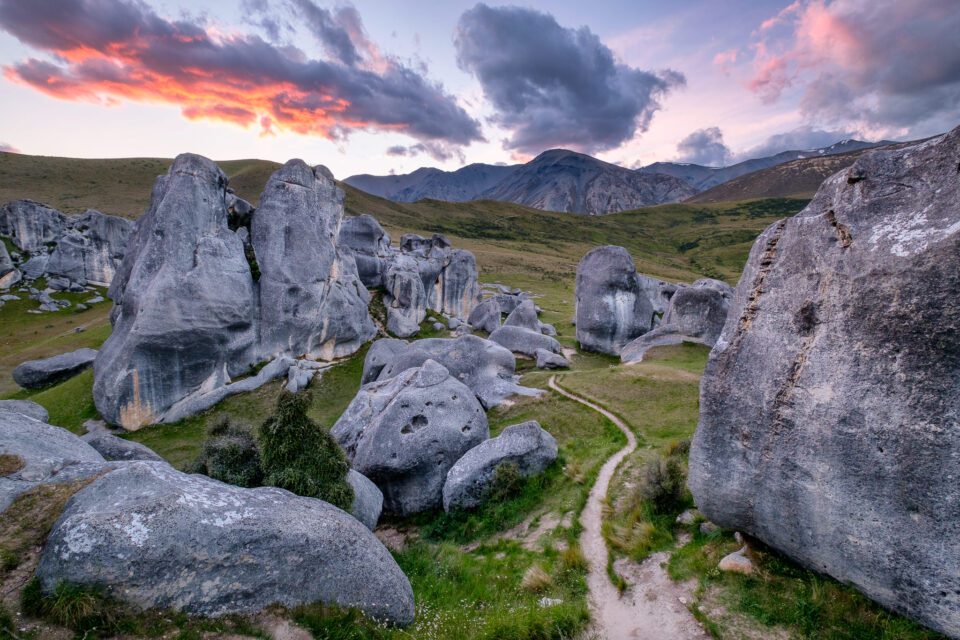
Factors to Consider When Choosing a Tripod
You lot started your tripod shopping spree and have no idea where to starting time. What factors exercise you demand to consider when purchasing a tripod? As I have pointed out above, purchasing a tripod can be an overwhelming experience, given how many different choices we are presented with from small and compact, to big and heavy. Let's become through each gene and identify your needs:
Weight Rating
The kickoff thing I would await at is how much weight a tripod can support. Many photographers make the mistake of buying a tripod that tin only support a few pounds and is not made for heavy photographic camera equipment. What ends up happening is obvious – at i point or another, the whole matter collapses, destroying the camera and the lens. Ever brand sure that the tripod y'all want to buy can support at to the lowest degree one.v times more than than the total weight of your camera and your heaviest lens. I say "at least" because I prefer to keep it at around 2x more. Do not forget that you volition at times utilise pressure on your camera and sometimes even residue your hands on the setup if you are shooting with long lenses, which adds to the weight. Yous might also add together a wink or a battery grip to your photographic camera in the time to come, or potentially shoot with something heavier, so you have to keep all of that in heed.
Tripod Elevation
I always recommend ownership a tripod that matches your summit, so that you do non accept to bend to look into the viewfinder. Once you put your camera on a tripod, the viewfinder should be at your centre level. It is OK if it goes higher than your eye level because you lot can e'er arrange the legs to be shorter. However, if it is much below your heart level, you will find yourself angle all the time, which can be a tiring feel, especially when you are waiting for some kind of activeness and need to constantly look through the viewfinder.
If you lot are buying a tripod with an fastened head, y'all want the tip of the head to be on your jaw level. If you are ownership a modular tripod with a split caput, make sure that the legs end approximately on your shoulder level.
Another factor to consider is tripod height when it is folded for easier travel. Do you need it to fit in your acquit-on baggage? Mine barely does diagonally, with anxiety removed, and I take it with me everywhere I go.
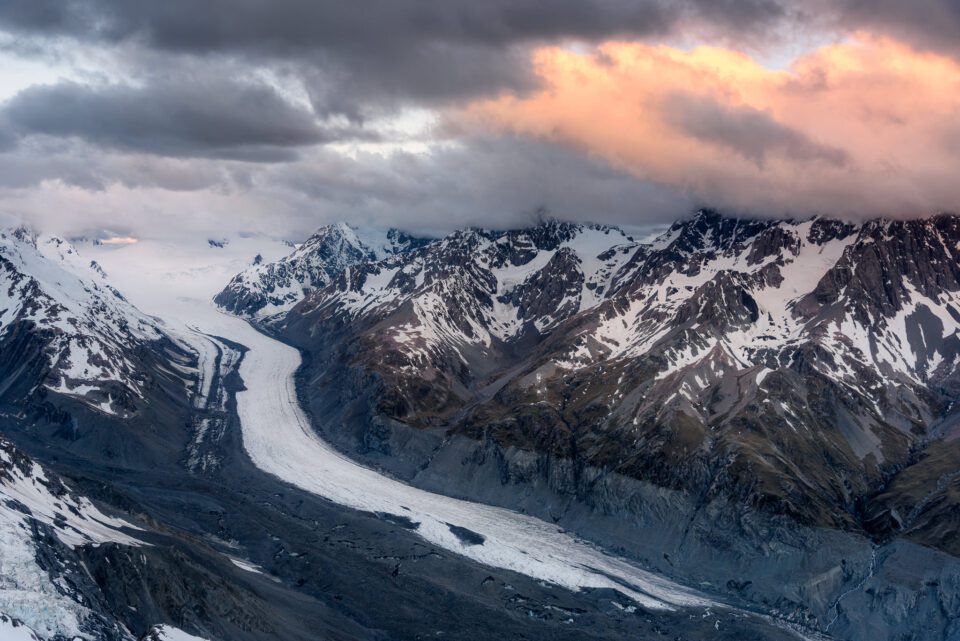
Tripod Weight and Construction
Weight is a pregnant cistron when choosing a tripod. You do non want your tripod to exist too heavy, because you volition find yourself leaving information technology at dwelling, rather than taking it with y'all on the road. The lightest tripods are made of carbon-fiber textile, which is extremely durable, stable and does not rust. While carbon-cobweb is the best material for a tripod, it, unfortunately, comes with a high price tag.
The next best construction material is aluminum, which is heavier than carbon cobweb. Most cheaper tripods are fabricated of aluminum today. You can also find tripods made of stainless steel, but those are by and large used for video equipment and are too heavy for regular use.
In terms of total weight, try to continue the tripod legs without the head under 5 pounds. Generally, carbon fiber legs are between 3 and iv pounds (only can be lighter or heavier depending on what they are made for), while aluminum legs can be between 5 and 6 pounds and heavier, depending on the size and how much weight they can support. Basalt lava legs are somewhere in-between both in terms of weight and cost.

Tripod Legs
Tripod legs generally come in two forms – tubular and non-tubular. All carbon-fiber legs come up in tubular course and have a threaded twist-lock system to secure the legs, while aluminum, basalt, and steel tripods might come in different shapes with a flip-lock. Depending on the maximum height of the tripod, there might exist between three and v sections on tripod legs. The more sections, the higher the tripod and by and large a trivial less stable.
Tripod Feet
Some advanced tripods volition allow you to supervene upon tripod anxiety for different conditions and situations – they simply unscrew on the bottom of the tripod legs. There are different types of tripod feet for indoors (rubber or plastic) and outdoor use (metallic spikes). Unless you are planning to shoot in icy, rainy/slippery conditions, the standard safety anxiety that come with your tripod should work simply fine.
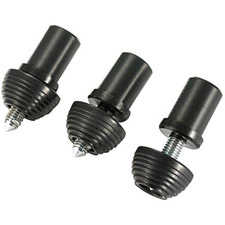
Centerpost
Some tripods come with a centerpost – a single leg in the heart of the tripod that allows y'all to increase or decrease the pinnacle of the camera by simply moving the centerpost in upward or downward direction. Although some photographers find it convenient and nice to have, I strongly advise against having a centerpost on a tripod. A centerpost defeats the whole purpose of a tripod – information technology is essentially the aforementioned thing as having a monopod on height of a tripod. It might non be equally pronounced if y'all are simply shooting with a wide-angle lens, but once y'all prepare a long telephoto lens, you volition quickly understand that using a centerpost volition cause too much vibration. If you still want to get a centerpost for whatever reason, make sure that it can fully decline to the aforementioned level as where the tripod legs meet. The centerpost should never wobble at its lowest level.
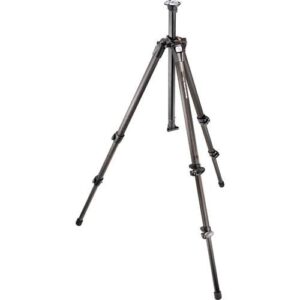
Tripod Head
A tripod head is the most essential role of the tripod organization. Information technology is responsible for securely property camera equipment and controlling camera motility. A modular tripod system does not come with a head and y'all accept to buy it separately. When choosing a tripod head, e'er make certain that it tin back up at least the same amount of weight your tripod legs tin can.
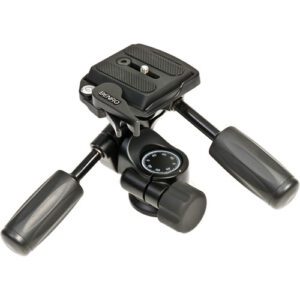
There are by and large three types of heads commonly available:
- Pan-Tilt Head – either with a single handle for horizontal motion or dual handles for both horizontal and vertical move. This is the most mutual type of head that is typically built into cheaper tripods.
- Ball-Head – compared to pan-tilt heads, ball-heads merely have one control that loosens or tightens the grip. They are very flexible and allow very smooth performance while keeping the camera/lens securely tightened.
- Gimbal Head – a specialized head for long and heavy 300mm+ lenses. Compared to pan-tilt heads and ball-heads, gimbal heads perfectly residue the camera and heavy lens and are best suited for fast-action photography. They are extremely easy to utilize in any management and do not require tightening the head every time the camera/lens moves.
I started out with a pan-tilt head and eventually switched over to a brawl-head with a quick-release organization (run into next), due to flexibility and easiness of utilize.

Quick-Release System
Every modern camera comes with a thread on its bottom that allows you to attach it to a tripod or a monopod (heavy lenses also come with a similar thread on the tripod neckband). This threaded arrangement makes it extremely inconvenient to adhere cameras and lenses on tripods considering you have to either rotate the camera or the tripod to attach them together. To get in easier and more user-friendly for photographers, manufacturers came upwardly with a dandy solution – to attach a small removable plate on the photographic camera or lens, which then tin be tightly secured on the tripod head.
Cheaper tripods come with a simple plastic plate that can be attached to any photographic camera or lens, while some of the more expensive tripod heads come with a more durable plate. The best quick-release system, however, is the Arca-Swiss Quick Release System. Information technology has more than or less become a standard among manufacturers and it has proven to exist a very effective solution for quick and piece of cake operation. Compared to plastic plates, the Arca-Swiss Quick Release System is fabricated of very strong aluminum and allows attaching the camera/lens on a tripod without the need to rotate anything. A quick-release plate is permanently attached to a photographic camera or lens, which then easily slides into a quick-release clench (pictured below). The locking machinery is uncomplicated, yet super tight for vibration-costless operation.
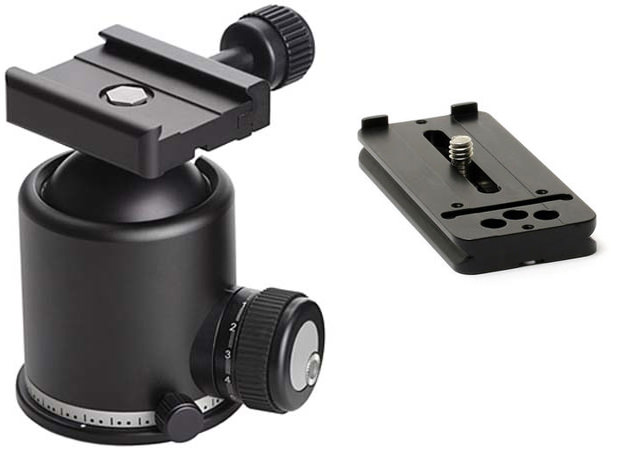
The beauty of this system is that some manufacturers like Really Correct Stuff and Kirk Enterprises offer not only plates for almost any camera and lens but also replacement lens tripod collars, wink brackets, L-brackets, and other accessories for the Arca-Swiss Quick Release System. The only downside of the Arca-Swiss Quick Release System is that it is not inexpensive – you besides take to buy split plates for each camera and lens.
Stability
A heavy tripod does non e'er mean that information technology is stable. In that location are plenty of tripod systems out there that are heavy and durable, yet lack the much-needed stability when used in various weather atmospheric condition. When a tripod is fully prepare up, it has to withstand non but wind but too occasional bumps and knocks that might happen in the field. You always need to make sure that your camera and lens balance on a tripod rather than lean towards one direction, because you might terminate upward damaging your equipment if the caput is non fully tightened or if the front outweighs the dorsum and everything falls on the ground.
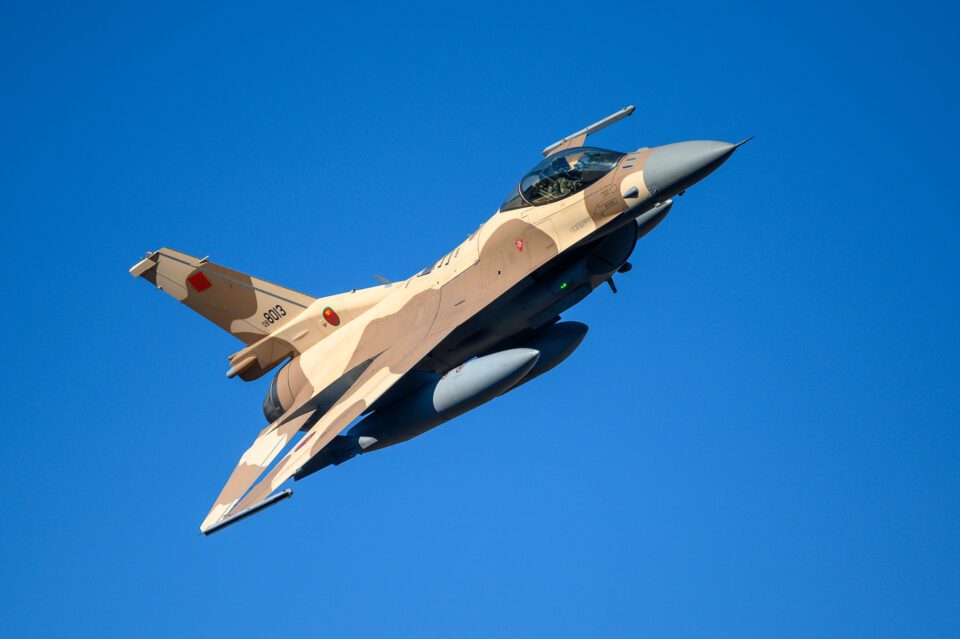
Which Tripod Should you Buy?
At present that you are familiar with all the criteria for selecting the correct tripod, you are probably wondering which tripod y'all should buy for your photography needs. Since I have numerously gone through the feel of shopping for tripods and have seen others do the same, let me tell you what many photographers end upwardly doing. They starting time expect for the cheapest tripod available that will exist practiced plenty to hold their first photographic camera, since they take no idea if they really need it or exercise not know how often they would be using information technology. The tripod would cost betwixt $75 and $150 for the legs and the head, which is a good price for a unproblematic tool.
Side by side, they purchase a longer and heavier lens and add more weight to the setup. All of a sudden, they detect that the cheap tripod is not good enough and they need something more durable and stable. Subsequently making the first error, they suddenly realize that they demand to practise more than research and they spend countless hours reading about tripods on dissimilar websites and forums. Despite all recommendations from the pros, they are not willing to invest on a pinnacle-of-the-line tripod with a good ball-head, and then they end up getting a pop tripod arrangement for $300-500 with a split up caput. Seems like a great investment and the tripod seems to be much better than the previous one.
Later on a year or 2, they realize that their concluding buy was non that adept, because the tripod is as well heavy and hard to use, specially for traveling. They realize that they should have listened to the pros in the beginning and bought a solid tripod system. Does this audio familiar? It certainly does for me, because I went through a similar experience and wasted too much effort and money.
Other photographers might have a dissimilar story, where they purchased an inexpensive tripod they like in the beginning and they are still happily using information technology today. All information technology says virtually them is that they are not using their tripods as much and what they have is good enough for occasional employ. Anybody who heavily relies on a tripod (especially landscape and architectural photographers) ends upwards ownership two to three dissimilar tripods to eventually finish up with the all-time.

It seems that information technology is hard to avoid purchasing multiple tripods because it is frequently impossible to justify the cost of a expert system for someone who does not heavily utilise a tripod. If someone told me that I would eventually spend more than than $500 on a tripod organization when I just got into photography, I would have never believed them – that's too much money to spend on a darn tripod! But information technology all turned out to be truthful, considering I actually ended upwards spending a lot more than than $500 overtime, and I wish I could become back in time and purchase the right stuff from the very get-go.
If I recommend someone who has just bought their get-go DSLR or a mirrorless camera to get the all-time tripod system that costs betwixt $800 and $1,200, I will almost certainly become a "you are crazy" await, no matter how well I explain my story. Therefore, here is what I would recommend:
- If yous currently do not have a tripod and y'all want to buy i, get the cheapest aluminum tripod arrangement with an integrated caput for less than $150 total. Why do I recommend the cheapest tripod? Because you lot kickoff need to understand how much y'all volition be using it. Half dozen months down the route you might end upwards doing other types of photography that exercise not require a tripod or y'all might notice yourself on a path of becoming a good landscape or macro photographer. A cheap tripod will requite you enough information to understand the existent role of a tripod in your photography.
- If y'all already have a cheap tripod and you desire to go something amend, save yourself a lot of money and frustration and become the all-time tripod with an Arca-swiss quick release system – skip the middle. Some people buy cheaper legs and heads and either find them too heavy or unstable. One common problem with other quick-release systems is the fact that cheaper plates do non grip well on cameras and kickoff wiggling and rotating relative to the base, making it a nightmare for things like panoramic photography.
Best Tripods to Buy
My tripod recommendations, based on the higher up, are divided into two categories: "low-budget" (under $150) and "top of the line" (over $500).
Low-upkeep Tripods (under $150)
Here are the best low-budget tripods nether $150 that I recommend:
- Sunpak Ultra 7000 – $69.99. Very cheap, weighs 4.ane pounds (ane.nine kg) and tin can support up to 12.3 pounds (5.half dozen kg) of total weight. This is very like to the first tripod I bought for myself from a local photographic camera store.
- Slik Pro AL-324DX Tripod with three-Way Pan/Tilt Head – $119.55. Although maximum pinnacle is likewise short at just 57.5″ (146 cm), information technology is reasonably lightweight at 3.8 pounds (1.72 kg) and can back up up to 8 lbs (iii.63 kg) of full weight. This would be a bang-up tripod to take on long hikes.
- Slik Pro 700DX Tripod with three-Mode Pan/Tilt Head – $139.95. Although it is a little heavy at vii pounds (3.18 kg), it can support upwardly to 15 pounds (6.8 kg) of total weight and tin be extended all the way to 74.viii″ (190 cm).
Peak-of-the-line Tripods (over $500)
Pinnacle-of-the-line tripod systems accept separate legs and replaceable heads. Let's start with the tripod legs. The all-time legs are made of carbon cobweb and manufactured by such brands every bit Gitzo (acme choice) and Really Right Stuff. I cannot really recommend a particular model, because you should cull one that fits your top and weight requirements. If you buy Gitzo, their best and the most stable line is the "Systematic" 6x Carbon Cobweb series without a heart column. I personally take an older version of the Gitzo Systematic legs that I have been happily using for years and they have never failed me once.
In terms of tripod heads, if you are non shooting with very long lenses, you should definitely go for a ball-head. Hither are the best ball-heads available in the market today:
- Arca-Swiss Z1 – $379.95. I have used this ball-head in the past and I really like it.
- Kirk BH1 – $385.00. An excellent culling to the Arca-Swiss Z1.
- Really Right Stuff BH-55 Pro – $415.00. Another dandy brawl-head that is better in quality than the Arca-Swiss Z1 and Kirk BH1.
- FLM CB-58 – $474.00. Some other superb ball-head with bully features (see my FLM Ballhead review)
These are all relatively big ball-heads with huge load capacities, which might be overkill for your particular needs. I recommend exploring other smaller brawl-heads past the higher up brands to meet if in that location is a better fit. For example, I personally stay abroad from full-size ball-heads, because they are huge and heavy. My preference is to apply smaller and lighter ball-heads that carry enough load to fit most of my needs, especially when traveling. My personal favorites are the RRS BH-30 and FLM CB-32 – these are the ball-heads I employ well-nigh often for my work.
If you are shooting with long and heavy lenses, your best selection is going to be the Wimberley Gimbal (top choice) or the much smaller Sidekick (requires a solid ball-caput to piece of work).
There are many other cheaper and more expensive brands out there that industry very solid ball-heads, but I'thousand non going to list through them all in this commodity.
I more than matter worth noting is that some of the higher-cease tripods sometimes come with a hook under the platform. Those can be useful to hang a haversack or a sandbag for boosted stability, but you have to be careful when shooting in windy weather, as it tin move the weight and potentially cause even more camera milkshake.
A Skillful Tripod is a Life-Long Investment
Unlike cameras and even lenses that come and go, a good tripod is a life-long investment. If you buy a good tripod that is easy to disassemble and reassemble, chances are, you will be able to easily clean and fifty-fifty repair it yourself without having to ship information technology anywhere. Well-known tripod manufacturers will provide long-term service and repair options in case any function of the tripod malfunctions or breaks. This style, yous do non have to worry nearly replacing your tripod in the hereafter…
Remember, with tripods, you frequently get what you pay for! Delight let me know if y'all accept any questions in the comments department below.
Source: https://photographylife.com/how-to-choose-and-buy-a-tripod-for-a-dslr-camera
Posted by: thomassathect.blogspot.com


0 Response to "Does The Camera Add Weight"
Post a Comment